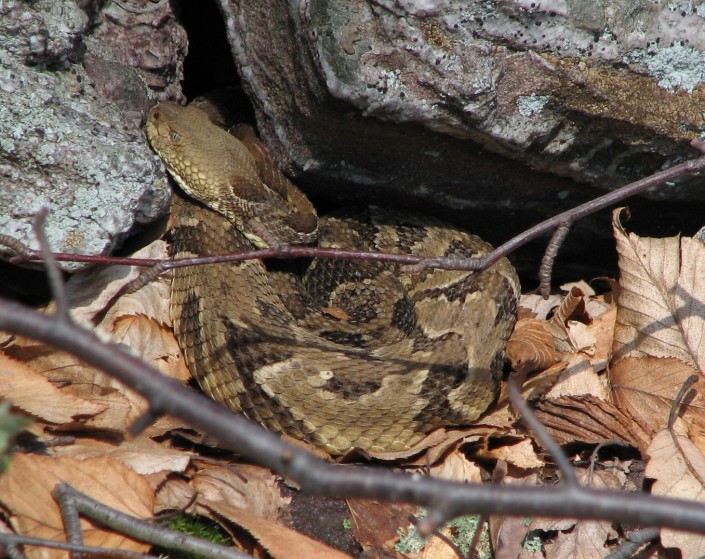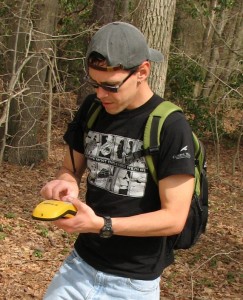Mapping Rattlesnake Dens in Northern New Jersey
PROTECTING WILDLIFE BY MAPPING THEIR HABITAT
By Michael J. Davenport, Marine Species & GIS Programs Manager

Having accurately mapped rare species data is essential for insuring that critical habitat for those species remains protected. For that reason, I recently accompanied Kris Schantz, a biologist from the NJ Endangered and Nongame Species Program, in documenting two timber rattlesnake den locations in northern New Jersey using a GPS (global positioning system) unit. Our goals were to see if the rattlesnakes had emerged from hibernation, survey how many were present, and to accurately map their locations in the heavily wooded area less than 30 miles outside New York City.

Timber rattlesnakes (Crotalus horridus horridus), like other reptiles, are cold-blooded. In order to survive through the long, cold winter in New Jersey, they hibernate in dens. Research has shown that rattlesnake dens in the northern part of the state can vary from rocky outcroppings with crevices, ledges or boulders to forest interior dens consisting of a few rocks and a hole in the ground. In New Jersey’s Pinelands, however, rattlesnake dens are quite different. Rattlesnake dens in the Pinelands are usually underground crevices near bodies of water, often underneath large tree roots.
Rattlesnakes will almost always use the same den year after year. In addition, rattlesnake young typically follow the scent trail of their mother in order to find their way to her den their first fall, or may follow any timber rattlesnake to a suitable den. As a result, a good den site may provide a winter refuge for a number of rattlesnakes of all age classes, as well as other species of snakes.
Since the goal of our mission was to map den locations, we had to make sure we arrived at the den site once it was warm enough for the rattlesnakes to come out of their crevasses to bask but before they had enough warm weather to travel away from the den site. Timing was crucial. After a week with some fairly warm days mixed with very cool nights and a few cool days, we ventured out during the last week of April on a day when the air temperature climbed into the lower 80’s.
The first den site we visited required a fairly long hike through a rocky, deciduous forest. Fortunately, Kris had visited both den sites several years earlier so she had a good idea of where we needed to go. We were fortunate to find two individuals at the den site, one yellow-phase juvenile and one yellow-phase sub-adult or young adult. While I GPSed the den site, Kris attempted to determine their sex based on their appearance (the young adult was a female but the juvenile’s sex could not be determined).
GPS units work when there is an unobstructed line of sight to four or more GPS satellites. With 7-8 satellites being detected by the GPS unit, my task of mapping the site was fairly easy and took little time. The trees had yet to leaf-out so my GPS unit had a clear signal from above. We also observed a northern black racer (Coluber constrictor constrictor) at the den site.
The second den site required a much longer and more strenuous hike accompanied by swarms of black flies. At that location, we observed three rattlesnakes – one black-phase adult (sex undetermined), one yellow-phase adult male, and one yellow-phase sub-adult or young adult (sex undetermined). GPSing this location took a little more effort though due to the terrain both because it was more difficult to get to the site and once there, the terrain made getting a clear signal on the GPS unit a little more tricky and it took far longer than at the first den.
Out of the five rattlesnakes we observed, only one ever rattled. Rattlesnakes rely on their camouflage as their first line of defense. Even when we were close by, they remained motionless. At no point did any of the snakes approach us or attempt to strike. The only two individuals which moved at all during our survey, moved away from us into rock crevasses and that was likely due to our prolonged presence staring at them.
Snakes, and venomous snakes in particular, have an undeserved bad reputation. At no point during our survey did I ever have any fear of being bitten by a rattlesnake. In all honesty, I was actually far more afraid of being bitten by a tick instead (I only found about four or five on me during the entire day).
For more information on timber rattlesnakes, visit Conserve Wildlife Foundation’s on-line field guide to New Jersey’s rare species at: http://www.conservewildlifenj.org/species/fieldguide/view/Crotalus%20horridus%20horridus/